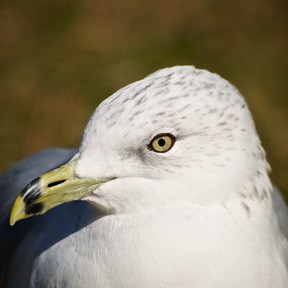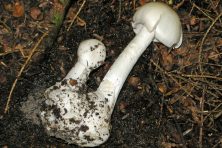AMBLE Volunteers Track Toxins in Door County
- Share
- Tweet
- Pin
- Share
When Jack Peterson takes his weekly walk along Europe Bay beach, he brings binoculars, a field guide and a shovel.
Peterson doesn’t just walk for exercise. He volunteers for the AMBLE program, and monitors 1.5 miles of beach for sick and dying birds that could carry avian botulism, a toxin that spreads through shoreline food webs and puzzles scientists. He counts healthy birds, tracks weather patterns, and looks for cladophora algae mats and round goby washed up on the beach.

Photo by Len Villano.
AMBLE, or Avian Monitoring for Botulism Lakeshore Events, is a U.S. Geological Survey (USGS) project that sends volunteers to beaches in Northeast Wisconsin. Beach monitoring is also happening along Michigan’s Upper Peninsula and the northeast shore of Lake Michigan to look for signs of avian botulism.
It’s part of a large effort to understand the toxin, which has increasingly caused fish and bird deaths in the last decade, including a die-off of 300 loons in Michigan in 2007.
The bacteria that causes the avian botulism toxin, Clostridium botulinum, is naturally in the environment but only creates the toxin under certain circumstances – warm places without oxygen.
“Given the right conditions, the bacterium creates a toxin,” said Jenny Chipault, USGS biologist and AMBLE coordinator. “How the toxin moves through the food chain and where the hot spot production is in the lake is what we’re trying to track down.”
There are still questions about how the toxin spreads and how invasive species might affect the cycle, but scientists think it works like this: avian botulism is produced in warm places without oxygen, like rotting cladophora algae mats. It then works its way up the food chain to fish, then fish-eating birds. The birds die, get eaten by maggots, then birds eat those maggots.
“It’s a giant web of things that are feeding into the system, and there’s few select points that we can understand,” said Marne Kaeske, stewardship coordinator at the Ridges Sanctuary.
Bird carcasses from Door County have tested positive for avian botulism, including a Ring-billed Gull in Sturgeon Bay and a Bald
Eagle in Ellison Bay, both found in 2012.
“With the water down and the growth of [excess] cladophora and so forth I would have been surprised if we didn’t have disease issues,” said Coggin Heeringa, director of Crossroads at Big Creek.
Burying dead birds is one way to stop the avian botulism cycle, so when Peterson encounters a bird carcass, that’s usually what he does.
In past years when Peterson encountered a dead bird, he would put on gloves, pick up the carcass and put it in a bag to send to a lab for testing. Now, since the federal sequester cut funding from government departments like the USGS, Peterson marks where he saw the carcass, buries it, and moves on.
Chipault said she’s scaling back on the observation part of the AMBLE program, and after this summer will focus on analyzing the data volunteers have collected for the last four years.
“The USGS as a whole had to make a cut,” Chipault said. “There is currently a travel freeze and a hiring freeze, so running a program in Door County out of Madison became challenging.”
Chipault’s contract was up in May, and for weeks didn’t know if she’d be allowed back to work. It was 3:56 pm on Friday, May 31, when she was told she could stay.
“She was ready to throw in the towel and we said no, there’d be a data gap,” Heeringa said.
In case Chipault couldn’t coordinate AMBLE, Heeringa and Kaeske offered to step in and organize volunteers to collect the data.
“I think it’s important if we can monitor one trend of something and in the long term I think we’re going to get good results,” Kaeske said. “Sustaining programs like this are pretty important.”
Other projects studying avian botulism include research on cladophora’s influence on outbreaks from the University of Minnesota, and a USGS study on loons, a common victim of avian botulism, and the birds’ eating patterns to see where they might pick up the toxin.

